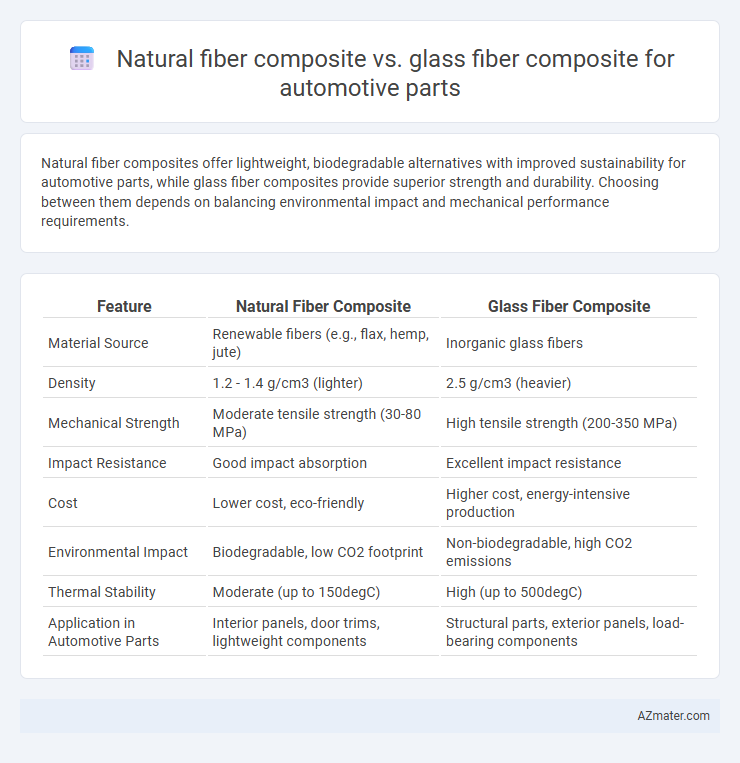Natural fiber composites offer lightweight, biodegradable alternatives with improved sustainability for automotive parts, while glass fiber composites provide superior strength and durability. Choosing between them depends on balancing environmental impact and mechanical performance requirements.
Table of Comparison
| Feature | Natural Fiber Composite | Glass Fiber Composite |
|---|---|---|
| Material Source | Renewable fibers (e.g., flax, hemp, jute) | Inorganic glass fibers |
| Density | 1.2 - 1.4 g/cm3 (lighter) | 2.5 g/cm3 (heavier) |
| Mechanical Strength | Moderate tensile strength (30-80 MPa) | High tensile strength (200-350 MPa) |
| Impact Resistance | Good impact absorption | Excellent impact resistance |
| Cost | Lower cost, eco-friendly | Higher cost, energy-intensive production |
| Environmental Impact | Biodegradable, low CO2 footprint | Non-biodegradable, high CO2 emissions |
| Thermal Stability | Moderate (up to 150degC) | High (up to 500degC) |
| Application in Automotive Parts | Interior panels, door trims, lightweight components | Structural parts, exterior panels, load-bearing components |
Introduction to Automotive Composites
Natural fiber composites, derived from renewable resources such as hemp, flax, and jute, offer significant advantages in automotive applications due to their lightweight, biodegradability, and superior vibration damping properties. Glass fiber composites, widely used in automotive parts, provide high strength, durability, and excellent resistance to corrosion and heat, making them suitable for load-bearing components. The evolving automotive industry increasingly adopts natural fiber composites to enhance sustainability, reduce vehicle weight, and meet stringent environmental regulations without compromising performance.
Overview of Natural Fiber Composites
Natural fiber composites consist of biodegradable fibers like hemp, flax, and jute embedded in a polymer matrix, offering lightweight and eco-friendly alternatives for automotive parts. These composites provide benefits such as reduced carbon footprint, lower production costs, and improved sound insulation compared to glass fiber composites. Although natural fiber composites generally have lower mechanical strength and moisture resistance than glass fiber composites, ongoing advancements in fiber treatments and hybrid designs are enhancing their performance in automotive applications.
Overview of Glass Fiber Composites
Glass fiber composites are widely used in automotive parts due to their high strength-to-weight ratio, excellent durability, and cost-effectiveness compared to natural fiber composites. Their superior mechanical properties and resistance to heat and chemical corrosion make them ideal for structural components and exterior panels. Despite their non-biodegradable nature, glass fiber composites offer enhanced performance and longevity critical for automotive applications.
Mechanical Properties Comparison
Natural fiber composites exhibit lower density and improved vibration absorption compared to glass fiber composites, providing enhanced comfort in automotive parts. Glass fiber composites demonstrate superior tensile strength, impact resistance, and stiffness, making them more suitable for load-bearing applications. The mechanical performance of natural fiber composites can be optimized through hybridization and treatment processes, yet glass fiber remains preferred for high-stress automotive components due to its robust mechanical durability.
Weight and Density Differences
Natural fiber composites for automotive parts typically exhibit lower density values, ranging between 1.2 to 1.4 g/cm3, compared to glass fiber composites, which average around 2.5 g/cm3. This lower density results in significant weight reduction, improving fuel efficiency and reducing vehicle emissions. Despite slightly lower mechanical strength, the lightweight advantage of natural fiber composites offers a compelling benefit for sustainable automotive design.
Environmental Impact and Sustainability
Natural fiber composites in automotive parts offer significant environmental benefits due to their biodegradability, lower carbon footprint, and renewable sourcing compared to glass fiber composites, which rely on energy-intensive manufacturing and non-renewable materials. The production of natural fibers like hemp, flax, or jute consumes less energy and generates fewer greenhouse gas emissions, enhancing overall sustainability in vehicle manufacturing. Despite glass fiber composites providing superior mechanical strength, the ecological advantages of natural fiber composites are driving increased adoption for lightweight, eco-friendly automotive components.
Cost Analysis and Manufacturing
Natural fiber composites offer a cost-effective alternative to glass fiber composites for automotive parts, primarily due to lower raw material prices and reduced energy consumption during processing. Manufacturing with natural fibers often involves simpler techniques such as compression molding, which cuts tooling and cycle times compared to the more energy-intensive processes required for glass fiber composites. Despite slightly lower mechanical properties, the overall production cost savings and environmental benefits make natural fiber composites attractive for non-structural automotive components.
Durability and Longevity in Automotive Usage
Natural fiber composites offer moderate durability and biodegradability but typically exhibit lower impact resistance and fatigue life compared to glass fiber composites in automotive applications. Glass fiber composites provide superior mechanical strength, higher thermal stability, and enhanced resistance to environmental factors, resulting in greater longevity and reliability for structural automotive parts. The increased lifespan and durability of glass fiber-reinforced composites make them more suitable for critical automotive components subjected to continuous mechanical stress and harsh operating conditions.
Applications in Automotive Parts
Natural fiber composites are increasingly used in automotive interior components such as door panels, dashboard covers, and seat backs due to their lightweight, biodegradability, and good sound absorption properties. Glass fiber composites dominate structural and exterior automotive parts like bumpers, hoods, and chassis components because of their superior strength, durability, and impact resistance. The choice between natural and glass fiber composites depends on balancing environmental benefits with mechanical performance requirements in automotive applications.
Future Trends and Innovations
Natural fiber composites are gaining traction in automotive parts due to their biodegradability, lightweight properties, and renewable sources, driving innovations in hybrid material designs and bio-based resin systems. Emerging trends emphasize enhancing mechanical performance and durability through fiber treatment technologies and nanocellulose integration, improving compatibility with thermoplastic matrices for mass production. Glass fiber composites continue evolving with advancements in recycling methods and modifications to reduce weight while maintaining high strength, but natural fiber composites lead the shift toward sustainable and eco-friendly automotive manufacturing.

Infographic: Natural fiber composite vs Glass fiber composite for Automotive part
 azmater.com
azmater.com